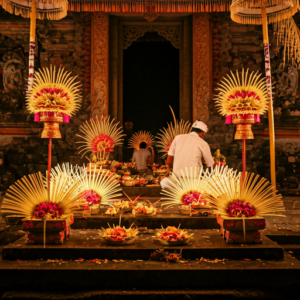Sacred temple ceremonies have long been a cornerstone of religious and cultural traditions worldwide. These awe-inspiring rituals provide a profound connection to the divine, a sense of community, and a way to honor ancient customs. Whether set in the majestic temples of Asia, the sacred groves of Africa, or the towering cathedrals of Europe, these ceremonies offer a glimpse into humanity’s timeless pursuit of spirituality and meaning. In this blog post, we’ll explore the significance, variety, and enduring impact of sacred temple ceremonies across cultures.
The Universal Language of Ritual
Temple ceremonies often transcend spoken language, relying instead on symbols, gestures, music, and rituals to communicate. From the flickering of sacred candles to the resonance of chanting monks, every element has a purpose.
At their core, these ceremonies serve as bridges between the human and the divine, offering participants a structured way to express gratitude, seek blessings, or mark life’s significant milestones. Whether practiced by a solitary monk or attended by thousands of devotees, each ritual carries deep symbolic meaning.
Sacred Ceremonies Around the World
1. Hindu Temple Rituals in India
Hinduism is renowned for its vibrant and intricate temple ceremonies. The daily puja (worship) is central to temple life, involving offerings of flowers, incense, food, and prayers to deities. Festivals like Diwali and Navratri bring temples to life with processions, dance, and music. One of the most breathtaking events is the Abhishekam, where deities are bathed in milk, honey, and sacred water to signify purification and renewal.
Ritual Highlight: Aarti
The Aarti ceremony is a sensory feast, where priests wave lit lamps in circular motions before the deity, accompanied by ringing bells and devotional songs. The ritual symbolizes the removal of darkness (ignorance) and the spreading of light (knowledge).
2. Buddhist Monastic Ceremonies in Southeast Asia
Buddhist temples, or wats, serve as spiritual hubs for monks and laypeople. In countries like Thailand and Myanmar, ceremonies often involve chanting, meditation, and offerings to Buddha. One notable event is the Kathina ceremony, where devotees present new robes to monks, strengthening communal ties and earning spiritual merit.
Ritual Highlight: Full Moon Celebrations
The full moon holds special significance in Buddhist traditions. Festivals like Vesak, celebrating Buddha’s birth, enlightenment, and passing, see temples illuminated by lanterns and devotees engaging in prayers and acts of kindness.
3. Christian Masses in European Cathedrals
Christian temple ceremonies, particularly the Mass, are central to Catholic and Orthodox traditions. These rituals include readings from the Bible, communal prayers, hymns, and the Eucharist, where bread and wine are consecrated and shared.
Ritual Highlight: Easter Vigil
The Easter Vigil, held in grand cathedrals, is a dramatic ceremony marking Christ’s resurrection. The lighting of the Paschal Candle, symbolizing Christ as the light of the world, is a powerful and unifying ritual.
4. Shinto Ceremonies in Japan
In Shinto, the indigenous spirituality of Japan, rituals are performed to honor kami (spirits) residing in nature and ancestors. Temples, known as jinja, host ceremonies that often involve purification rites and offerings of sake, rice, and other symbolic items.
Ritual Highlight: Matsuri Festivals
Seasonal festivals, or matsuri, celebrate everything from harvests to historical events. These vibrant ceremonies include parades, traditional music, and dances, blending spirituality with community celebration.
5. African Tribal Rituals in Sacred Groves
In many African cultures, sacred groves serve as temples where ceremonies honor ancestors, spirits, and deities. Rituals often include drumming, dancing, and storytelling, creating a dynamic connection between the physical and spiritual realms.
Ritual Highlight: Initiation Ceremonies
Initiation ceremonies mark the transition from childhood to adulthood, involving spiritual teachings, symbolic acts, and community bonding. These rites affirm the individual’s role within the community and their connection to ancestral wisdom.
The Role of Symbolism in Temple Ceremonies
Symbols are central to sacred ceremonies, carrying meanings that resonate deeply with participants. Common elements include:
- Fire and Light: Representing purification, enlightenment, and the divine presence.
- Water: Symbolizing cleansing, renewal, and life.
- Offerings: Acts of devotion, gratitude, and sacrifice, ranging from simple flowers to elaborate feasts.
- Sacred Sounds: Chants, hymns, and instrumental music create an atmosphere of reverence and focus.
Modern Relevance of Sacred Temple Ceremonies
In a world increasingly driven by technology and materialism, temple ceremonies offer a sanctuary of peace and reflection. They remind us of the importance of community, the interconnectedness of life, and the enduring quest for meaning. Moreover, these rituals preserve cultural heritage, passing down traditions and values to future generations.
Experiencing Sacred Ceremonies as a Visitor
For those interested in witnessing or participating in temple ceremonies, here are a few tips:
- Research Cultural Norms: Understand the customs and expectations of the specific tradition.
- Dress Modestly: Many temples have strict dress codes to maintain sanctity.
- Observe Respectfully: Avoid interrupting rituals or taking photos without permission.
- Engage Mindfully: While observing, take time to reflect on the ceremony’s deeper meanings.
The Transformative Power of Rituals
Participating in or witnessing a sacred temple ceremony can be a deeply moving experience. The atmosphere of reverence, the communal spirit, and the connection to something greater than oneself can evoke a sense of awe and inner peace. These moments remind us of our shared humanity and the universal quest for transcendence.
Conclusion
Sacred temple ceremonies are more than religious obligations—they are living embodiments of humanity’s spiritual aspirations. They bridge the gap between the mundane and the divine, offering solace, inspiration, and a sense of purpose. Whether you seek personal growth, cultural understanding, or simply a moment of serenity, these ceremonies invite you to pause, reflect, and reconnect with the sacred.






